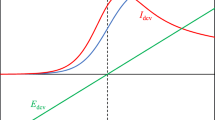Abstract
As a means to illustrate the calculation of an optimal cell-voltage control for a parallel-plate reactor, we determine the time-varying cell voltage that maximizes p-aminophenol produced from the electroreduction of nitrobenzene in a differential-conversion reactor operated in a batch mode; that is, the electrolyte is continuously recirculated from a batch holding tank through the reactor in which a low conversion per pass occurs. A rationale is given for restricting the search for the optimal control for this particular reaction network to a chattering-cell voltage that switches between a priori chosen minimum and maximum values. The optimal, time-varying duty cycle is computed using a gradient-search technique. The predicted concentrations are dependent upon the reaction time; for the conditions examined here, an improvement of twenty-five percent in the production and nine-hundred percent in the selectivity of p-aminophenol may be achieved by using the optimal, time-varying voltage in comparison to the best steady value. Since a chattering control is a mathematical construct, we illustrate that a rectangular, high-frequency waveform may be applied to yield results which are indistinguishable from those effected by a chattering cell voltage. The period of the waveform must be short enough so that surface concentrations are time invariant over it and yet, simultaneously, must be long enough so that double-layer charging does not account for a significant passage of coulombs.
Similar content being viewed by others
Abbreviations
- a :
-
cathode surface area per unit volume of electrolyte (cm−1)
- C :
-
electrode capacitance (µF cm−2)
- c i :
-
bulk concentration of species i (mol cm−3)
- c i 0 :
-
initial concentration of species i (mol cm−3)
- c is :
-
concentration of species i at electrode surface (mol cm−3)
- E a :
-
anode potential (V)
- E c :
-
cathode potential (V)
- f :
-
F/RT (V−1)
- F :
-
Faraday constant (96 487 C mol−1)
- i :
-
current density (A cm−2)
- I :
-
current (A)
- I k :
-
kth value of a chattering current (A)
- I eff :
-
current efficiency
- i k :
-
kth value of a chattering i (A cm−2)
- k 1 :
-
heterogeneous rate constant for the reaction NB → PHA (cm s−1)
- k 2 :
-
heterogeneous rate constant for the reaction PHA → AN (cm s−1)
- k 3 :
-
homogeneous rate constant for the reaction PHA → PAP (s−1)
- k mi :
-
mass-transfer coefficient of species i (cm s−1)
- R :
-
gas constant (8.314J mol−1 K−1)
- R j :
-
kinetic resistance at electrode j (Ω cm2)
- R Ω :
-
ohmic resistance (Ω cm2)
- r i :
-
reaction rate for species i (mol cm−3 s−1 for homogeneous reaction, and mol cm−2 s−1 for heterogeneous reaction)
- T :
-
temperature (K)
- t :
-
time (s)
- t f :
-
batch reaction time (s)
- u i :
-
ith component of control vector u
- u ci :
-
exp (−αiϕE c)
- V :
-
cell voltage (V)
- V :
-
V k
- kth:
-
value of a chattering-cell voltage (V)
- θ(t):
-
duty cycle for a chattering control
- Ω:
-
duty cycle for a rectangular waveform
- Δt :
-
period of the rectangular waveform (s)
- α:
-
transfer coefficient (Equations 1–4)
- 0:
-
indicates exchange current
- a:
-
anode
- c:
-
cathode
References
P. S. Fedkiw and W. D. Scott, J. Electrochem. Soc. 131 (1984) 1304.
T. R. Nolen and P. S. Fedkiw, J. Appl. Electrochem. 20 (1990) 370.
J. C. Smeltzer and P. S. Fedkiw, J. Electrochem. Soc. 139 (1992) 1358.
Idem, 139 (1992) 1366.
R. Bakshi and P. S. Fedkiw, J. Appl. Electrochem. 23 (1993) 715.
R. Bakshi, PhD. dissertation, North Carolina State University, Raleigh, NC (1992).
M. Fjeld, Chem. Eng. Sci. 29 (1974) 921.
R. V. Gamkrelidze, ‘Principles of Optimal Control Theory’, Plenum Press, New York (1978).
IMSL MATH/LIBRARY, ‘FORTRAN Subroutines for Mathematical Applications’, IMSL, Houston, TX (1982).
M. Minoux, ‘Mathematical Programming’, Wiley-Interscience, New York (1986).
J. C. Dunn, Control and Dynamic Systems 29(2) (1988) 135.
J. E. Bailey, Chem. Engr. Commun. 1 (1977) 111.
J. C. Puippe and N. Ibl, J. Appl. Electrochem. 10 (1980) 775.
Author information
Authors and Affiliations
Rights and permissions
About this article
Cite this article
Bakshi, R., Fedkiw, P.S. Optimal time-varying cell-voltage control of a parallel-plate reactor. J Appl Electrochem 24, 1116–1123 (1994). https://doi.org/10.1007/BF00241309
Received:
Revised:
Issue Date:
DOI: https://doi.org/10.1007/BF00241309




